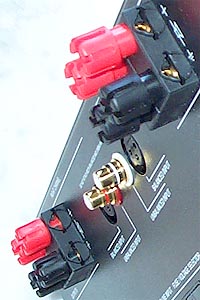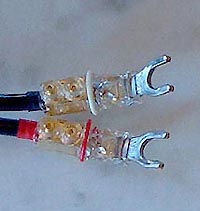|
|
 |
|
|
|
 |
|
|
 |
|
 |
|
|
|
|
Remember the old Threshold/Forté electronics? Eric Lauchli, B.D. Dale and Lorin Peterson were part of the original Threshold design team. In 1985, they formed Continuum Electronics as an "independent design and engineering consultancy". That's shorthand for OEM design house - |
|
 |
|
a think-tank for hire. By 1989, the desire to produce its own brand renamed the firm Coda Technologies. In 1995, the Continuum Electronics name was resurrected to introduce the current lineup of the Window remote-control preamplifier, the Stage 3 Series of stereo amplifiers, the multi-channel 4.3.2 Theater amplifier, and the subject of today's review - the Unison integrated amplifier.
The longevity of the team behind the product? It suggests admirable stability despite what appears to have been numerous corporate overhauls. The former is perhaps slyly indicated by the umbrella's moniker? It certainly is further compounded by the fact that Coda continues to design and manufacture for numerous other firms. Two of those I'm familiar with. While OEM contracts entail non-disclosure, I can disclose this: These two brands enjoy high renown in the industry. One of them in particular has garnered enviable reviews for its Coda-built electronics. Which, in a straight-forward way, led to today's assignment. After all, Coda has made others look and sound good. Wasn't it high time they collected kudos for their own prowess, by way of products they could openly claim and accept credit for?
Sure sounded fair to me. One look at the two boxes (the other the matching stand-alone amp - more on that later) underscored that Coda is an old hand at manufacturing indeed. Shy of a forklift tearing into them, even left-footed UPS couldn't damage these amps. We all know how bloody hard they seem to try, too. This utterly and especially confounds European makers. Packaging that survives the rigors of global travails inexplicably finds itself lethally challenged after crossing US customs. Lifting the Unison out of its extra-plush foam surroundings rang the upstairs slot machine again. The perpendicular heat sinks were nicely rounded off, all edges smoothed over to prevent cutting up your hands. Ka-chinnng. Two for the home team!
|
|
Remember Cher's and Nick Cage's Moonstruck movie though? Cher's philandering dad is out on a pre-coitus cultural date. The lady's disappointed that sugar daddy hasn't complimented her on the fancy dress befitting the operatic occasion. Having his small head on more, ahem - pressing matters, the old plumber attempts to focus on the wrappings rather than desert at hand. After protracted silence, he manages to utter the blatantly obvious: "It's very - red." This by way of suggesting that the Unison's faceplate with its elegantly contoured details is very black indeed. The white silkscreen's high contrast but not the last word in elegance. A soft silver or grey instead would have been my interior design instinct. Why mention this? At $2,950 factory-direct ($2,665 if you forego the 14-day in-home trial program), the Unison Stage 3 integrated must compete with $5000+ competitors sold through regular retail outlets. In those leagues, persnickety details considered gratuitous whining at lower price points do become vital. Practical ones too. What's wrong with the lower pictures, pray tell?
|
|
|
|
|
|
 |
|
|
The CE-approved binding posts feature lateral slots for spade insertion. The bad news? They were too narrow and too thin to accomodate the WBT spades of my HMS cables; the Analysis Plus spades on my Oval 8; or the spades on my Acoustic Zen Satori. Three strikes and you're out. As the photo proves, I'm not talking spades of insaniac or non-standard dimensions. These are run-of-the-mill while top-shelf spades, attached to the kind of upscale cables a prospective customer should be expected to use. Never mind that what I use for reviews is hardly a secret. Don't manufacturers do their bloody home work before sending stuff out to ornery writers?
If, like yours truly, you additionally stack spades for discrete bi-wiring which my Avantgardes -- surprise, surprise -- require? On the Unison's single terminals (unlike the stand-alone amp's in the picture) fuhgeddaboudid, bubba. Now, make me an offer I can't refuse. You see, as an ex-manufacturer, I probably tend to err on their side when it comes to nitpicks. I know in too much detail what the process of making stuff (rather than writing about it) entails. Still, I'm penning for the end user. As much as it pains me to say so, this choice of binding posts is asinine, unforgiveable and in dire need of immediate rectification. And -- to get this off my chest once and for all -- I just hope that Coda won't fire off a sorry-ass manufacturer's reply about CE approval! Every amp maker in the US book must deal with these idiotic regulations. I have $349 and $800 amps in-house at this very moment that deal with this issue more eloquently. As Coda's fortunes would have it, my backup set of Analysis Plus Oval 9 is a shot-gun terminated WBT-banana affair. I could produce sound. Otherwise (and I'm dead serious about this) I would have sent this amp back as unusable. Period.
End of rant. Most everything else about this product is so thoughtfully implemented that this inexplicable oversight required a sharp aim and full volley of verbal ordinance. Well, there are three further points of contention: The digital volume display adopts the reasoning that 99dB attenuation equals zero dB output, hence ramping the volume up (less attenuation) must equate to diminishing numbers. Just imagine the hapless duffer who hits "play" while the readout showed 0.
|
|
 |
|
 |
|
With 103dB efficient speakers like my Avantgardes, you'd blow a few things to smithereens. Could you sue Coda for your mistake? I doubt it. While technically correct, I surmise that engineering dweebs had a hand in this, not marketing guys in touch with how actual end users think. Bel Canto's convention is far more intutive. Let the numbers increase while the output voltage rises. 0 = no sound, 99 = run for cover. Not the reverse! My urgent suggestion to Coda? Recode the micro-processor display. Why risk potential mishaps or even just confusion? This counter-intutive scheme tripped me up repeatedly even though I nervously thought about it a priori each and every time.
|
|
|
Contention #2? The included remote, while controlling all necessary functions like volume up/down, input selection, separate activation of monitor and processor functions, balance (for each channel and the subwoofer output), and mute, doesn't excude the kind of ritz all-metal units by BAT, Bel Canto, Cary, cj etc. do. A nice practical feature, however? A miniature red command-active LED tucked in the right corner just abode the volume key - it lights up whenever you press any key, to confirm battery power and that the remote is, in fact, emitting infra-red orders. More beer, please!
Contention #3? The monstrous 2,000VA toroidal transformer hums a bit. Granted, most oversize humdinger trannies have that propensity. Still, I'm always irked to have such mechanical noise intrude into the between-tracks silences when the overall noise floor is low enough to hear it. |
|
 |
|
On the subject of noise, upwards of the 18dB reading, power supply noise of the amp's 26db gain structure became objectionable on my hornspeakers. To put that into perspective, average listening levels on the DUOs equated from minus 50 to minus 30, this depending on party mood and recording level. Hence it was never an issue. It's mentioned only because my zero-feedback tube amps manage to be quieter. Now, before you suspect that I'm on the warpath headed for Sacramento where Coda makes its home (I'm not; can't find a feather that looks good enough on my head) onward ho now to the Unison's many features and technical descriptions. There's much to admire indeed. And wait until we're talking sonics. There's a reason why I wanted to slay these gremlins first. From here on out, it's clear sailing all the way.
|
|
|
|
 |
|
 |
|
|
|
|
|
|
|
|
|
|
|
|
|
|